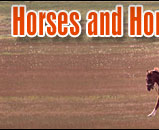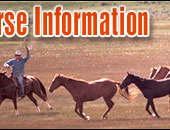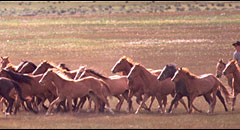 |
   |
|
|
|
You are here:
Horses
> Horse health >
Horse Back Pain and Injuries
|
|
Equine Back Pain and Injuries:
Horse Arthritis, Poor Saddle Fit and Riding Stress Could Cause Soreness
Equines use their back for almost every motion they make.
The vertebra, muscles, tendons, ligaments, and nerves in a
horse’s back are extremely important for even the most
basic movements. If there is even a small problem in a
horse’s back, the horse can suffer greatly. Horses can be
extremely irritated by back problems, which is why owners
should be aware of the symptoms and how to treat equine
back pain. |
|
|
Symptoms of Equine Back Pain
If your horse is suffering from back pain, here are a few
symptoms that might lead you to suspect it. In the beginning
stages of back pain, a horse’s performance will decrease or
change noticeably. They may not be trotting or might look
like they are walking gingerly. Owners may also notice their
attitude might be a little off. They may be unusually
irritable and might not welcome you to groom them or even
touch their back area. If you try to ride them, they could
be quite aggressive in getting you off. |
What to Expect with Mature or Elderly
Horses
although many horses are able to work
for 15 or more years, there are greater
chances that as a horse ages, they will
develop back problems. Working horses
tend to be more prone or at risk of
developing chronic back pain with age.
Working horses are more likely to fall
and cause permanent damage to their
body. Most horses will try to get
through the pain and will alter their
movement to avoid the pain. They will
work still, and is up to owners to
notice a difference in the way a horse
is moving.
Horses can also take a bad fall in their
stall or pen that could cause permanent
injury to their backs. A sudden change
of behavior is the most common symptom
of this kind of injury. For instance,
you may put your healthy horse in his
pen for the night, however, the next
morning your horse could be sore or
lame.
In jumping horses, the horse might
refuse to round their back or refuse to
jump completely if they are suffer from
back pain discomfort. If they do jump
through the pain, they may start
twisting their body unusually to avoid
the pain. This changed in behavior may
be slight at first, but will usually
persist or worsen over time if not
treated. The first sign of back pain
problem or what is causing the pain can
sometimes is difficult to detect since
it is very dynamic condition.
Causes of Back Pain
There are multiple injuries and
activities that can cause back pain in a
horse. This makes it very difficult to
detect what exactly is causing the pain.
A common cause of back pain in older,
heavily exercised horses is arthritis of
the hock. The horse will use overuse the
back muscles to take pressure off the
hocks.
A vet can use several different
approaches to find out what the source
of the back pain may be. A veterinarian
will often start with a basic physical
examination of the horse and look for
common causes of back soreness that are
not always linked to the back directly.
During these tests vet may use flexation
tests, radiographs, localized anesthesia
and blocks to assist in their diagnosis.
These tests are fairly effective in
determining where the pain is coming
from and its severity.
If arthritis is the cause found, joint
injections are often used to treat the
pain. Problems in the feet detected in
radiographs may show the horse is not
being properly shoed or trimmed
incorrectly. A horse that walks on
incorrect shoes can develop lameness.
Imbalance riders or saddles can also be
a common source of back pain or injury. It is
vital that the saddle be checked and
fitted every six to twelve months.
Choosing the proper saddle for your
horse is very important for his or her
health. If you don’t choose the proper
saddle, the seat can cause the weight to
be unevenly distributed on the horse’s
back A comfortable horse is a healthy
horse!

|
Read the next horse health tips article on Bowed tendons. |
|
|
|
|
 |
|
|
 |
 |
  
Visit Equestrian Cupid now.
The best and largest equestrian club for meeting the other half for friendship and marriage
|
|
 |
|
|
|
Horse Education
|
|
|
|
|
Horse Information Topics
|
|
|
|
|
|
|
|
Horse Business Owners
|
| |
Advertise with Us
Have your horse products or services exposed to over 27,000 of our monthly visitors.
|
|
|
|
|
|